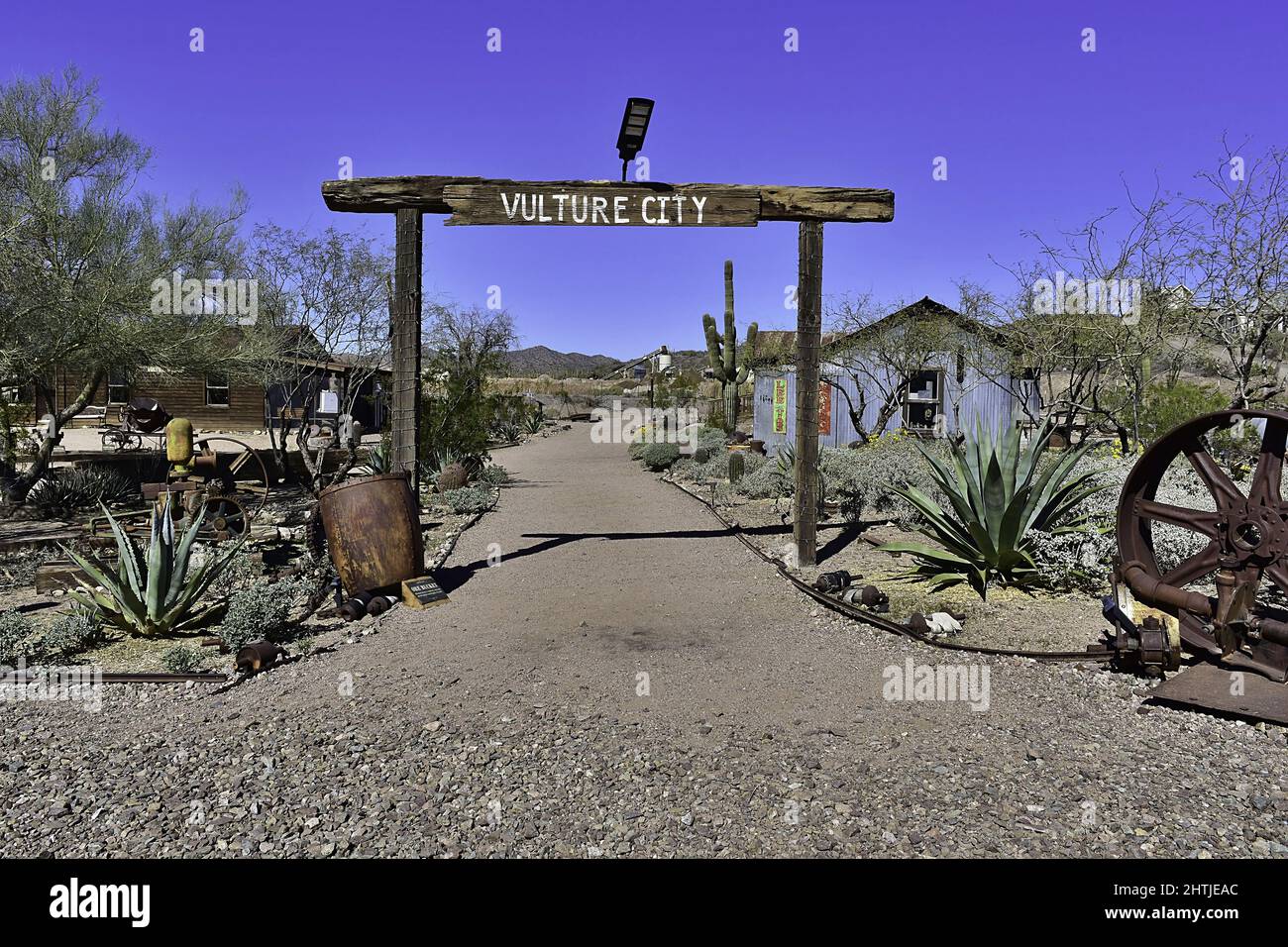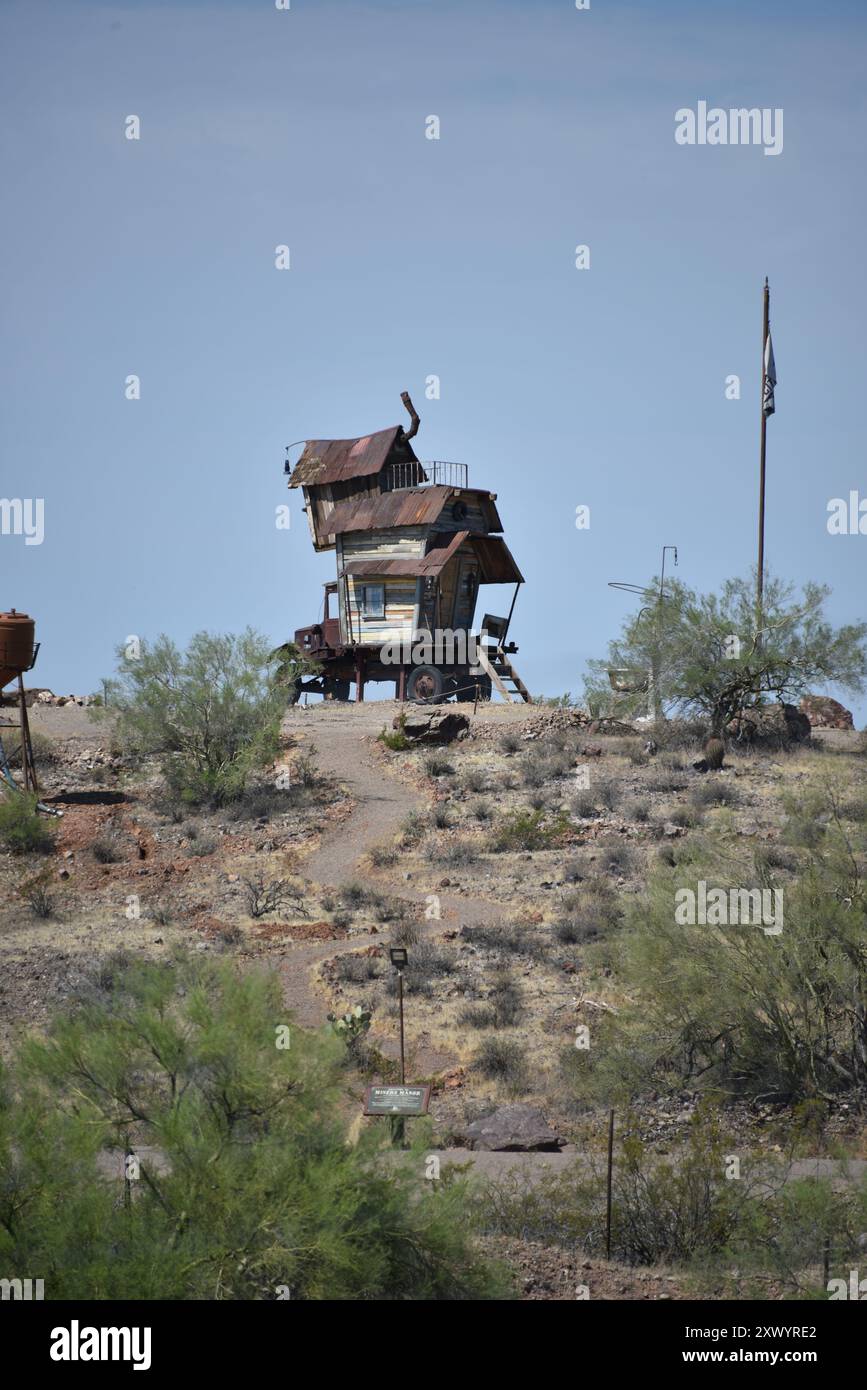
Echoes in the Dust: Unearthing the Ghosts of Vulture City, Arizona
The Arizona sun, a relentless sentinel, beats down on a landscape that seems to defy life itself. Cacti stand like stoic sentinels, their spines glinting under the cerulean sky. The air shimmers with heat, carrying only the whisper of the wind through parched brush. Here, amidst the rugged, unforgiving beauty of the Sonoran Desert, lies Vulture City – a name that evokes both the predatory nature of the landscape and the scavengers that once circled its boom-and-bust cycle.
Once a bustling hub of ambition, greed, and the raw, unvarnished spirit of the American West, Vulture City today is a poignant tableau of abandonment. Its skeletal remains – crumbling adobe walls, rusted mining equipment, and the spectral shadows of forgotten lives – stand as a stark, sun-baked testament to a bygone era. It’s a ghost town, yes, but not one merely filled with silence; it resonates with the echoes of fortunes made and lost, of dreams pursued and shattered, and of the sheer, tenacious will to survive in an environment determined to reclaim its own.
To truly understand Vulture City is to understand the very heart of Arizona’s pioneering spirit. It was born from the discovery of gold, a shimmering promise in the desolate earth, and it grew with the feverish intensity of a desert mirage. Its story is not just a chapter in local history; it’s a microcosm of the grand, often brutal, narrative of the gold rush, where humanity’s basest desires and noblest aspirations clashed under an indifferent sky.

The Golden Spark: Henry Wickenburg and the Vulture Mine
The year was 1863. The American Civil War raged thousands of miles to the east, but in the nascent Arizona Territory, a different kind of battle was being fought: one against the elements, against isolation, and for the elusive glimmer of prosperity. It was in this crucible that Henry Wickenburg, an Austrian prospector with a keen eye and an iron will, stumbled upon what would become Arizona’s richest gold strike.
The legend goes that Wickenburg, while hunting, spotted a peculiar outcropping of rock, dark and jagged, much like the birds of prey that circled overhead. Some say the name "Vulture" came from these rock formations; others insist it was simply due to the ubiquitous presence of the scavengers, ever watchful for the unwary. Regardless of its exact origin, the name stuck, and the Vulture Mine was born. What Wickenburg had found was not merely a vein of gold, but a mountain of it. He began to chip away at the quartz, revealing pockets of free-milling gold so rich that, as one historical account put it, "a man could simply pry it out with a pickaxe."
News of the strike spread like wildfire, carried by word of mouth and the desperate hopes of countless prospectors. Men flocked from all corners of the country, abandoning farms, families, and failed ventures, drawn by the siren call of instant wealth. Within a few years, Vulture City sprang into existence, a sprawling, chaotic testament to human ambition. At its peak, the town boasted a population of 5,000 hardy souls, making it one of the largest settlements in the Arizona Territory.
Life in the Crucible: A Brutal Wager
Life in Vulture City was a brutal wager against nature and human nature. The town was carved out of an unforgiving desert, miles from any established supply route. Water, the most precious commodity, had to be hauled over 20 miles from the Hassayampa River, a monumental task that required teams of oxen and wagons, making it more expensive than whiskey. The heat was relentless, often soaring above 120 degrees Fahrenheit in the summer, turning every day into a test of endurance.
"They say the dust tasted like gold, but mostly it just tasted like thirst," a fictionalized old-timer might recount. "And the sun? That sun could bake the sense right out of a man."
Beyond the elements, Vulture City was a frontier town in its truest, wildest sense. Law and order were often a distant concept, enforced sporadically by local marshals or, more frequently, by the swift, brutal justice of the mob. Saloons, gambling halls, and dance houses thrived, fueled by the transient wealth of the miners. Shootouts were common, disputes over claims or card games often ending in bloodshed. The infamous "Hanging Tree," a gnarled ironwood still standing today, served as a stark reminder of the town’s harsh justice, said to have been the final resting place for over a dozen men.

Adding to the danger were the Apache, who viewed the influx of miners as an invasion of their ancestral lands. Raids were a constant threat, forcing the miners to build a small fort, known as "Fort Wickenburg," for protection. Every journey to transport ore or fetch supplies was fraught with peril, a perilous dance between the promise of gold and the threat of an ambush.
The Economic Engine: Gold, Sweat, and Fortune
Despite the hardships, the Vulture Mine proved to be an astonishingly productive enterprise. Over its active years, it yielded an estimated $200 million worth of gold in today’s currency, a staggering sum that significantly contributed to the economic development of the Arizona Territory. The mine became the backbone of the region, its output fueling not just Vulture City, but also the growth of nearby Wickenburg, named after the mine’s discoverer.
The town itself was a vibrant, if chaotic, hub. It boasted an assay office, where the precious ore was weighed and valued; a mercantile store, selling everything from flour to firearms; a blacksmith shop, vital for keeping mining equipment in working order; and even a schoolhouse, a testament to the brief hope for stability and future generations. The Vulture Mine wasn’t just a hole in the ground; it was a complex operation employing hundreds of men, from experienced hard-rock miners to common laborers, all toiling under the desert sun, extracting wealth from the earth.
For decades, the mine continued to produce, its deep shafts burrowing further into the earth, following the elusive veins of gold. But even the richest strikes eventually begin to thin, and the challenges of deep mining in such a remote location began to mount.
The Slow Fade: When the Veins Ran Thin
Like many boomtowns of the American West, Vulture City’s prosperity was inherently tied to the finite nature of its resource. By the early 20th century, the easily accessible gold had been extracted. Mining deeper became exponentially more difficult and expensive, requiring advanced machinery and techniques. Adding to the mine’s woes were persistent legal disputes over ownership and claims, which often led to shutdowns and operational instability.
The once-thriving population began to dwindle. Miners, ever in search of the next big strike, moved on to greener pastures. Businesses, deprived of their customer base, shuttered their doors. The grand dreams that had built Vulture City began to erode, slowly but surely, under the relentless gaze of the desert sun. By the 1940s, the Vulture Mine had largely ceased operations, and Vulture City itself was little more than a ghost of its former self. The buildings, once teeming with life and noise, fell silent, their timbers creaking under the weight of abandonment, their adobe walls slowly crumbling back into the dust from which they had been formed.
Nature, with its infinite patience, began its reclamation. The desert winds scoured the remnants, carrying away fragments of the past, while the tenacious flora began to creep back, intertwining with the decaying structures.
A Living Museum: Preserving the Past
Yet, Vulture City was not entirely lost to the sands of time. Unlike many ghost towns that were completely razed or scavenged for building materials, a significant portion of Vulture City survived, largely due to private ownership and a dedicated effort to preserve its historical integrity. Today, it stands as one of Arizona’s best-preserved ghost towns, offering a unique window into the harsh realities of frontier life.
Visitors to Vulture City can wander among the remaining 12 original structures, each whispering its own story. The Assay Office, where fortunes were officially declared; the Mess Hall, where weary miners found sustenance; the Blacksmith Shop, its forge now cold; the sprawling Stone Cabin, one of the oldest buildings; and, of course, the infamous Hanging Tree. The sheer scale of the mine itself, with its gaping shafts and towering headframes, speaks volumes about the monumental effort required to extract the gold.
"It’s not just a collection of old buildings," says a modern-day guide, their voice resonating with passion amidst the silence. "It’s a living, breathing testament to the human spirit. You can almost hear the shouts of the miners, the clinking of glasses in the saloon, the creak of wagon wheels. It forces you to imagine what it took to build a life out here."
Vulture City has become a popular destination for history enthusiasts, photographers, and filmmakers seeking authentic backdrops for tales of the Old West. It serves as a powerful educational tool, allowing visitors to connect tangibly with the challenges and triumphs of those who shaped the American frontier. The ongoing preservation efforts are crucial, battling against both the elements and the inevitable decay of time, ensuring that future generations can walk these dusty streets and feel the weight of history.
The Enduring Legacy
As the sun begins its descent, casting long, dramatic shadows across the desert floor, Vulture City takes on an almost mystical quality. The air cools, and the silence deepens, broken only by the rustle of a nocturnal creature or the distant call of an owl. In these moments, the ghosts of Vulture City seem most palpable – not as specters, but as the enduring spirit of those who dared to dream of gold in the desert.
Vulture City stands as a stark, sun-baked testament to the transient nature of wealth, the indomitable spirit of humanity, and the relentless power of the natural world. It reminds us that behind every glittering fortune and every grand tale of the Old West, there was immense hardship, fierce determination, and the quiet dignity of ordinary people striving to carve out a life against impossible odds.
It is more than just a ghost town; it is a repository of stories, a silent chronicler of the boom and bust, the hope and despair, that defined an era. As visitors depart, leaving the old buildings to their solitude once more, they carry with them not just memories of a historic site, but a deeper understanding of the echoes that still reverberate from the dust-choked streets of Vulture City, Arizona. Its story, etched in stone and sand, continues to remind us that even in abandonment, there is profound history, and in silence, a powerful narrative.


